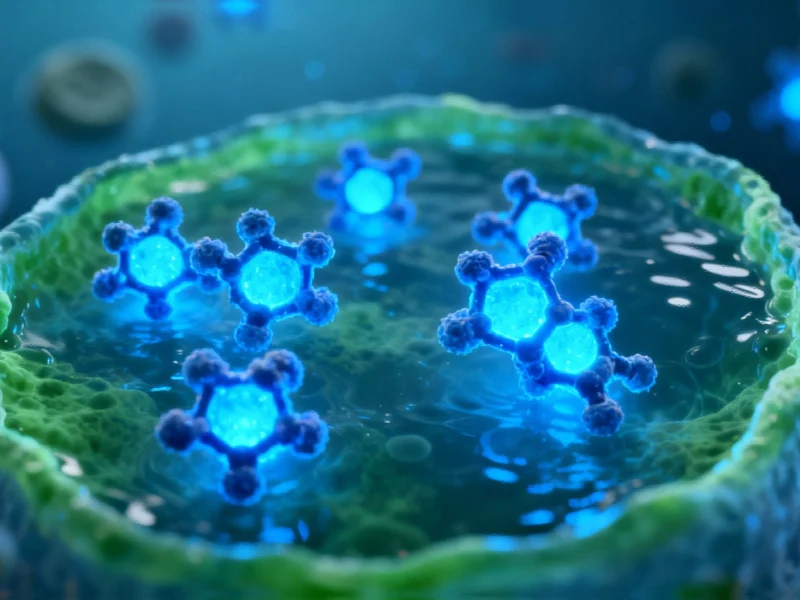In a remarkable scientific breakthrough that defies conventional chemical behavior, researchers from the University of Malaga and IBIMA Plataforma BIONAND have developed an innovative family of fluorescent molecules that actually enhance their luminosity in aqueous environments. This discovery represents a significant advancement in biomedical imaging technology, particularly for studying living cells without compromising their integrity.
The research team, comprising experts from the Departments of Physical Chemistry and Organic Chemistry, has created molecules that perform contrary to established principles of fluorescent chemistry. While traditional fluorescent dyes typically diminish in intensity or shift to duller colors when introduced to water or biological media, these new compounds demonstrate increased fluorescence intensity and shift toward the blue region of the light spectrum. This counterintuitive behavior makes them exceptionally valuable for biomedical applications where aqueous environments are fundamental.
Professor Ezequiel Pérez-Inestrosa, who co-directed the study alongside Carlos Benítez Martín and Francisco Nájera Albendín, emphasized the significance of this development. “These molecules not only challenge established rules in fluorescent chemistry but also provide unprecedented capabilities for cellular imaging in native biological conditions,” he noted. The research findings, recently published in the prestigious journal Advanced Materials, highlight how this innovation could transform cellular visualization techniques.
Enhanced Performance in Biological Environments
The most extraordinary aspect of these new fluorescent molecules lies in their improved performance precisely where it matters most – within living cells. Unlike conventional dyes that often quench or fade in aqueous solutions, these molecules maintain and even enhance their brightness under real-use conditions. This characteristic is particularly crucial for biomedical research, where accurate visualization of cellular components requires dyes that perform reliably in water-based environments.
José Manuel Marín Beloqui, Juan T. López Navarrete, and Juan Casado Cordón, key researchers involved in the project, explained that the molecules’ unique photophysical properties enable them to overcome the limitations that have long plagued fluorescent imaging in wet conditions. This advancement comes at a time when technological limitations in detection systems remain a challenge across various scientific fields.
Advanced Imaging Applications
The practical applications of this discovery are already demonstrating remarkable potential. Through multiphoton microscopy techniques, researchers can now “photograph” the interior of cells with exceptional precision without causing cellular damage. This non-invasive imaging method allows for deeper penetration into living tissues, producing clearer and safer images than previously possible.
What makes these molecules particularly valuable is their selective targeting capability. They demonstrate a remarkable affinity for mitochondria – the cellular powerhouses responsible for energy production. This selective marking enables researchers to study mitochondrial function with unprecedented clarity, which is crucial for understanding diseases where mitochondrial dysfunction plays a key role, including cancer and neurodegenerative disorders. The ability to monitor these vital organelles in real-time represents a significant step forward in both basic research and clinical applications, similar to how early warning systems in other fields provide critical insights through timely detection.
Manufacturing and Accessibility Advantages
Beyond their superior performance characteristics, these new fluorescent molecules offer significant practical advantages in terms of production and accessibility. The research team has developed synthesis methods that are both simpler and more cost-effective than those required for conventional fluorescent dyes. This manufacturing efficiency could democratize advanced cellular imaging techniques, making them available to a broader range of research institutions and clinical settings.
The economic accessibility of these dyes opens new possibilities for diagnostic tool development. Researchers envision that these molecules could lead to more affordable and widely available tools for studying essential cellular processes, potentially improving early disease detection capabilities. This approach mirrors the importance of accessible monitoring systems across various technological domains, where cost-effectiveness determines widespread adoption.
Future Implications and Research Directions
The implications of this discovery extend far beyond immediate laboratory applications. The research team believes their work represents a paradigm shift in how scientists approach fluorescent molecule design for biological applications. By demonstrating that molecules can be engineered to perform better in aqueous environments rather than worse, they’ve opened new avenues for chemical innovation.
Professor Juan Casado Cordón expressed enthusiasm about the broader implications: “This is a perfect example of what can be achieved when fundamental chemistry research converges with applied biomedical science. The possibilities for future development are tremendous.” The team continues to explore additional applications and refinements, including potential uses in advanced research systems that require reliable detection mechanisms in challenging environments.
As research progresses, these fluorescent molecules may find applications in drug development, diagnostic imaging, and fundamental biological research. Their unique properties position them as valuable tools for advancing our understanding of cellular processes and developing new approaches to disease diagnosis and treatment. The convergence of materials science and biomedicine demonstrated in this research highlights the transformative potential of interdisciplinary collaboration in addressing complex scientific challenges.
Based on reporting by {‘uri’: ‘phys.org’, ‘dataType’: ‘news’, ‘title’: ‘Phys.org’, ‘description’: ‘Phys.org internet news portal provides the latest news on science including: Physics, Space Science, Earth Science, Health and Medicine’, ‘location’: {‘type’: ‘place’, ‘geoNamesId’: ‘3042237’, ‘label’: {‘eng’: ‘Douglas, Isle of Man’}, ‘population’: 26218, ‘lat’: 54.15, ‘long’: -4.48333, ‘country’: {‘type’: ‘country’, ‘geoNamesId’: ‘3042225’, ‘label’: {‘eng’: ‘Isle of Man’}, ‘population’: 75049, ‘lat’: 54.25, ‘long’: -4.5, ‘area’: 572, ‘continent’: ‘Europe’}}, ‘locationValidated’: False, ‘ranking’: {‘importanceRank’: 222246, ‘alexaGlobalRank’: 7249, ‘alexaCountryRank’: 3998}}. This article aggregates information from publicly available sources. All trademarks and copyrights belong to their respective owners.



